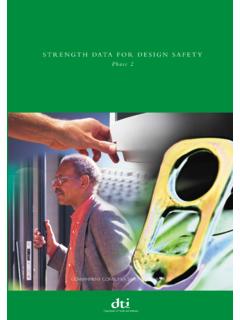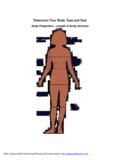Transcription of International Encyclopedia of Ergonomics and Human Factors
1 International Encyclopedia of Ergonomics and Human Factors Enviromental Ergonomics E0412 i Contents About the editor xvii Board of Associate Editors xix International Scientific Advisory Board xxi Foreword xxv Acknowledgements xxvii Part 1 General Ergonomics An annotated review of selected military and government sources of Human Factors design related criteria 3. Australia: Ergonomics Society of Australia 8. Biosketch: Corwin Bennett 10. Biosketch: Etienne Grandjean 11. Biosketch: Jean-Marie Faverge 13. Biosketch: Longin Paluszkiewicz 14. Biosketch: Paul Branton 15. Biosketch: Paul Morris Fitts 17. Biosketch: Ross A. McFarland 19. Biosketch: Wojciech Bogumil Jastrzebowski 21. Cognitive engineering 22. Core competencies in Ergonomics 25. Cultural Ergonomics 31. Defining Ergonomics / Human Factors 35. Design 38. Ecological approach 39. Epistemological issues about Ergonomics and Human Factors 43. Ergonomics in the Nordic countries 47.
2 The European Union's policy in the occupational safety and health sector 48. Exposure assessment of upper limb repetitive movements: a consensus document 52. Finnish Ergonomics Society 67. Fundamental concepts of Human Factors 68. Germany: Gesellschaft f r Arbeitswissenschaft 71. Greece: Hellenic Ergonomics Society (HES) 72. History of Human Factors in United States 73. A history of Human Factors / Ergonomics in power systems 76. History of the Gesellschaft f r Arbeitswissenschaft (GfA) 88. History of work-related musculoskeletal disorders 91. Human Factors , politics and power 94. Human machine systems: written and symbolic communication 97. Iceland: Icelandic Ergonomics Society 100. IEA definitions of Ergonomics 102. The International Ergonomics Association (IEA) 103. International Ergonomics standards: ISO/TC 159 106. Ireland: Irish Ergonomics Society 109. ISO and CEN Standardization Committee for Ergonomics (1999): Organizational structure 110.
3 Israel: Israel Ergonomics Society 122. Enviromental Ergonomics E0412 vii Italian Society of Ergonomics (Societ Italiana di Ergonomia, SIE) 123. Macroergonomics 124. Ontology 126. An outline of Ergonomics , or the science of work based upon the truths drawn from the science of nature 129. Person-centered Ergonomics 142. Poland: Polish Ergonomics Society 145. Professional certification in Ergonomics in the USA 146. Scenario-based design 160. South Africa: Ergonomics Society of South Africa (ESSA) 164. Spain: Spanish Ergonomics Association 165. Symvatology: the science of an artifact Human compatibility 166. Taiwan: Ergonomics Society of Taiwan 171. Task analysis 172. Training and acquisition of complex tasks 175. United Kingdom: The Ergonomics Society 178. United States: Human Factors and Ergonomics Society 180. Universal design for the aging 182. Part 2 Human Characteristics Alternative controls 187. Anaerobic threshold 190.
4 Anthropometric databases 191. Anthropometry of children 193. Anthropometric terms 197. Anthropometry 198. Body sizes of US Americans 199. Control of rapid actions: motor programming 202. Dynamic muscle strength 205. Dynamic properties of Human limb segments 207. Engineering anthropometry 211. Ergophthalmology: the visual system and work 212. Event-related potentials 219. Force exertion: pinching characteristics and strengths 223. Force exertion for (consumer) product design: information for the design process 226. Force exertion for (consumer) product design: problem definition 229. Force exertion for (consumer) product design: research and design 232. Gaze-based control 234. Gesture-based control 237. Hand grip strength 240. Hand-grip torque strength 247. Handgrip characteristics and strength 252. Human muscle 255. Information processing 256. Lifting strategies 260. Maximum holding times of static standing postures 263.
5 Models of attention 266. Multiple resources 271. Muscle strength 276. Muscle terms glossary 277. Musculo-skeletal system 278. Physical ability testing 279. Physical strength in the older population 282. Physical work capacity (PWC) 285. Postural adaptation 287. Principles of simple movements 292. Psychophysiological fitness for work 296. viii Enviromental Ergonomics E0412. Push and pull data 299. Pushing and pulling strengths 317. Recumbents 320. Sleeping postures 323. Static and dynamic strength 327. Static muscle strength 328. Strength testing 330. Torque data 334. Trunk muscle force models 343. Visual perception, age, and driving 348. Workload and electro-encephalography dynamics 350. Part 3 Performance Related Factors Activity 355. Activity theory 358. Allocation of functions: past, present and future perspectives 363. Arousal states and Human performance 370. Attention and Human performance: a cognitive neuroscience approach 374.
6 Body postures 378. Brain and muscle signal-based control 379. Burnout 382. Cognitive modeling in Human computer interaction 387. Cognitive psychophysiology in Ergonomics and Human Factors 392. Combination manual handling tasks 395. Comfort-discomfort phase change 399. Constraints in design decision-making 403. Cross-cultural comparison of computer anxiety: concept, measures and related variables 406. Cybersickness in virtual reality 410. Databases for psychophysically acceptable maximum weights and forces in manual handling tasks developed by Liberty Mutual 413. Databases for psychophysically acceptable maximum wrist torques in manual tasks for females developed by Liberty Mutual 423. Design cognition 426. Designing for body strength 431. Driver perception and response 433. Dynamic situations 436. Ergotoxicology: towards an operational prevention of chemical risk in the working environment 454. Fatigue and driving 446.
7 Fire-fighting and rescue work in emergency situations and Ergonomics 449. Human control of the behavioral environment 454. Human error 463. Human reliability analysis 466. Learning and forgetting 470. Lifting techniques 476. Loads on the lumbar spine during dynamic work 479. Manual materials handling in unusual postures 484. Manual materials handling: multi-person lifting 485. Manual work and back stress in industrially developing countries 487. Mental fatigue and related phenomena 491. Mental models 493. Mental workability and an increasing life span 497. Mental workload 500. Mental workload measurement 504. Mental workload: theory, measurement and application 507. Models of Human performance for application to military simulation 510. Monitoring an operator's psychophysiological fitness for work 513. Noise: measuring, evaluation, and rating in Ergonomics 516. Occupational stress mechanisms 524. Enviromental Ergonomics E0412 ix Physical demands of work 526.
8 Psychophysical risk assessment in manual handling 536. Rating scales for perceived physical effort and exertion 538. Signal detection theory 542. Signal detection theory alternatives 546. Situation awareness 551. Situation awareness in teams 555. Skill learning: augmented feedback 558. Skill learning: conditions of training 562. Sleeping systems: current status 566. Sleeping systems: design requirements 571. Standing work 577. Static load 580. Static work capacity 583. Stimulus response compatibility 586. The substance of cognitive modeling 590. Tolerance to shiftwork 593. Visual display terminals: age and psychophysiology 597. Visual measurement: modern methods 599. Visual perception under night driving conditions 602. Work ability 604. Work design: age related policies 606. Work hazards and risk assessment in Human performance 609. Working with age: an ergonomic approach to aging on the job 613. Part 4 Information Presentation and Communication Alarm initiated activities 623.
9 Auditory warnings 625. Augmented reality 628. Automatic speech recognition 631. Chinese keyboard input 636. Convergence of telephony, television and computing in the home 640. Cross-cultural issues in Human computer interaction 644. Cultural aspects of user interface acceptance 648. Describing and predicting Human interaction with technology 651. Design of menus: choosing names, organization and selection devices 655. Ecological interface design theory 659. Ergonomics of CAD systems 663. Functional systems design versus interface design 668. HCI hypermedia: usability issues 670. Human acceptance of information technology 673. Human computer interaction (HCI) standards 676. Human Factors and digital networks: intranets, extranets, and the internet 680. Human speech digitization and compression 683. Human ecology: developing ecological auditory warnings 686. Human Computer Interaction (HCI) 689. Hypertext and hypermedia 691.
10 Information design: warning signs and labels 695. Interactive speech technology 698. Internet and the World Wide Web 701. Knowledge management in HCI design 705. Knowledge-based man-modeling: job design procedure 711. Models of graphical perception 715. Multimedia production 720. Natural language communication 725. Product sensorial quality 728. x Enviromental Ergonomics E0412. Speech-based alarm displays 733. Structured Integration of Human Factors and software engineering methods 735. Top ten mistakes in web design 738. Universal design in Human computer interaction 741. Use of modern Chinese language 746. User requirements in information technology 750. User-centered graphic design 754. Video telephony 757. Virtual environments 765. Virtual reality 768. Virtual reality: virtual and synthetic environments technologies and applications 772. VR technology for Ergonomics design 783. Part 5 Display and Control Design Auditory Warnings and Displays: issues relating to design and selection 791.





